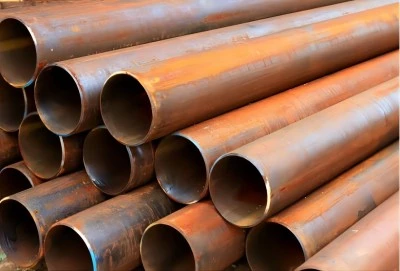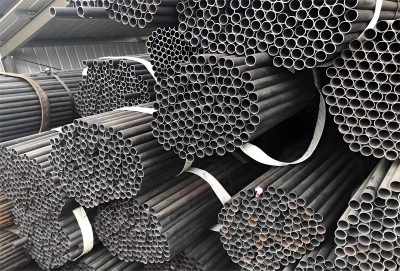Overview of S235JR Steel Pipe Size
Due to its excellent mechanical properties and weldability, S235JR steel pipe is a popular material choice in a variety of industries. Engineers, contractors, and buyers need to know how big S235JR pipes are to make sure they are used and chosen correctly. The standards and most important parameters pertaining to S235JR pipe dimensions are discussed in this section.
The European standards for S235JR Pipe sizes are mostly followed, with EN 10219 being the most frequently cited specification. Non-alloy and fine-grain steel cold-formed welded structural hollow sections are covered by this standard. EN 10210 for hot-finished structural hollow sections and ISO 4200 for general-purpose plain end steel pipes are two additional relevant standards.
The outer diameter, wall thickness, and length of S235JR pipes are the most important dimensional parameters. The measurement of the outer diameter is taken along the widest point of the circular cross-section of the pipe. The distance that separates the inner and outer surfaces of the pipe wall is referred to as the wall thickness. The total linear measurement of the pipe from one end to the other is typically indicated by length. The pipe's strength, weight, and suitability for specific applications are all dependent on these parameters.
|
|
|
Common Size Specifications
To meet a variety of industrial requirements, S235JR pipes are available in a wide range of standard sizes. Wall thicknesses typically range from 2.0 mm to 40 mm, and common outer diameters range from 21.3 mm to 610 mm. Although other lengths may be available upon request, the standard lengths are typically 6 or 12 meters.
Manufacturers offer customization options for special size requirements that are not covered by standard specifications. Typically, this means sending the manufacturer detailed requirements, and the manufacturer looks at whether or not production is possible. Non-standard sizes may come with additional costs and minimum order quantities.
Take into account the particular requirements of the application when selecting S235JR Pipe sizes. Higher loads may necessitate thicker walls and larger diameters for structural applications. In contrast, applications that place weight reduction first might choose thinner walls or smaller diameters while still adhering to the required strength. To ensure that the selected size meets your project's specific requirements, always consult a qualified engineer or the manufacturer's technical team.
Precautions For The Selection of S235JR Pipe Size
There are a number of factors to take into careful consideration when choosing the right size of S235JR Pipe. Always consult the project engineers' design drawings and specifications, first and foremost. The precise dimensions and tolerances for the pipes that will be used in the project are outlined in these documents.
Take into consideration the processing technology that will be used on the pipes after they are purchased. For instance, if the pipes are going to be bent, check to see that the size you chose gives them enough flexibility without compromising their structural integrity. In a similar vein, if welding is required, select a wall thickness that can withstand heat input without causing mechanical properties to change or distort.
Establishment space is one more basic figure size choice. Take measurements of the installation area's available space and allow for the necessary clearances. This is especially important in tight or complicated environments where larger pipe sizes may make installation or maintenance more difficult.
Customization And Processing
Customization is frequently required for projects that call for S235JR Pipe sizes that are not standard. Typically, the first step in this process is a comprehensive meeting with the manufacturer to discuss specific requirements like dimensions, tolerances, and the required quantity. After that, the manufacturer will look into whether or not production is possible and give you a price. When compared to standard sizes, custom sizes may have longer lead times and higher minimum order quantities.
Cutting, bending, and welding are all common ways to process S235JR pipes. Depending on the level of precision required, cutting can be performed using sawing, plasma cutting, or laser cutting techniques. Sections can be curved by bending, and the minimum bending radius is determined by the pipe's diameter and wall thickness. For the purpose of joining pipe sections or attaching fittings, welding is frequently utilized. Proper procedures are required to preserve the structural integrity of the pipe.
S235JR pipes' final dimensions can be altered by processing. For instance, bending may result in a slight ovalization of the cross-section, whereas welding may cause distortion and localized heating. It is essential to work with skilled fabricators who are familiar with the S235JR steel's material properties and are able to implement appropriate controls to maintain dimensional accuracy in order to mitigate these effects.
Contact Longma
S235JR Pipe from LONGMA GROUP are of high quality and meet the requirements of the EN10210 standard. In order to guarantee dimensional precision and consistent mechanical properties, our pipes are manufactured in accordance with stringent quality control procedures. Our staff is prepared to assist you in selecting the appropriate S235JR pipes for your project, regardless of whether you require standard sizes or custom specifications.
For inquiries about our S235JR pipe offerings or to discuss your specific requirements, please contact us at info@longma-group.com. Our technical experts are available to provide guidance on size selection, customization options, and processing capabilities to meet your project needs.














